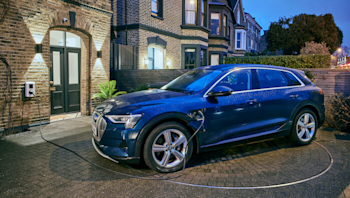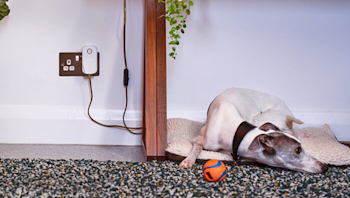7 predictions for the smart home of the future
What will be tomorrow’s take on eco-friendly living? Futurologist Tom Cheesewright shares his predictions for how smart homes will enable us to live more sustainably.
Changing how we live is crucial to tackling the climate emergency and it’s something we can all contribute to. And most of us want to - according to our latest research 88% of Brits want to move to a more sustainable future.
However, despite the desire for greener living, our survey showed that 41% of people don’t know where to start, and 37% don’t think it will be an easy transition. According to Futurologist Tom Cheesewright, smart tech will be central to fuelling a green future, making adoption easier. “Smart tech used to be complicated and expensive, but now it’s simple and affordable,” he says. “Hive is a great example: its eco-system of solutions to manage heating, lighting and electricity is now helping people cut their carbon footprint in over 1.9 million UK homes.”
Here at Hive, we’ve teamed up with Tom to share his predictions on the role of smart tech in making our homes more sustainable, as well as managing our carbon footprint. “People need to know how smart tech will further benefit them not only from a sustainability point of view, but also to their wider lives, be it financially or through added convenience.”
Tom’s takes on tomorrow’s tech 1:
“By 2030, almost every UK home will have some form of smart tech.”
Expensive to buy and install, smart gadgets used to be what Tom calls ‘footballer tech’ – only an option if you’re loaded. Fortunately, technology advances quickly, and it’s becoming cheaper, more powerful and – critically – easier to use. “As innovation continues, sustainable smart home products will become the norm, with smart options becoming increasingly the obvious choice to replace things like thermostats and bulbs,” says Tom.
Tom’s takes on tomorrow’s tech 2:
“Around a third of all UK cars will be electric by 2030.”
Electric vehicles will be cheaper to produce than fossil-fuelled ones by 2027 so prices will fall even as the technology improves. The uptick in EV uptake will have repercussions on home life too, as people opt for the convenience of at-home charging. “With brands like Hive, charging at home will be a part of a wider eco-system of smart tech that adds convenience and integrates energy storage into your smart home.” Tom says.
Tom’s takes on tomorrow’s tech 3:
“Homes will generate and store energy and be rewarded for making their homes part of the energy grid.”
Solar power is set to increase from around a million homes today, and other energy generation options will also come into the picture. “Smart water tanks, heat pumps, EV chargers and home batteries could all take part in the future energy system,” says Tom. This means you can use power when it’s cheaper (and greener), as well as storing it for use when it’s needed – either by you or someone else.
Tom’s takes on tomorrow’s tech 4:
“The home may become a giant computer with robot furniture.”
We already have robot vacuums, and appliances like this will become smaller, sleeker and cheaper, while other household essentials will also get the tech treatment. “We’ll see everything from robot furniture that can transform at the touch of a button to make the best use of your living space, to robot wardrobes that press and fold your clothes and smart hydroponics systems to give you a constant supply of salad veg,” says Tom.
Tom’s takes on tomorrow’s tech 5:
“15-20% of the UK will continue to work from home.”
A legacy of lockdown, many people don’t want to return to the office full-time, and they may spend what they save on commuting on green improvements to insulation, ventilation and soundproofing. “Using one centralised app, such as the Hive app, we’ll see more people linking their devices together in one eco-system to better monitor and manage their energy usage and costs,” says Tom. Using Hive Actions, you can ensure lights are only on when someone is in the room, or that the heating switches off when a window is opened.
Tom’s takes on tomorrow’s tech 6:
“Semi-communal living will become increasingly popular.”
With the size of homes shrinking, but not their cost, coupled with people staying single for longer, semi-communal living makes sense: smaller, more sustainably designed private spaces with access to shared amenities like gyms and remote working spaces. “Smart tech will play a key role in these, managing access, setting heat and lighting to our preferences, and ensuring security from your phone through ecosystems like Hive,” says Tom. “We’ll also see a rise in micro grids, especially in new builds, where you can share energy within the community. This means energy can easily be transferred to different homes, instead of wasted.”
Tom’s takes on tomorrow’s tech 7:
“Suburban office shares will be in demand – and need to be sustainable.”
Families and flatmates alike struggled with finding suitable spaces to work from home and bickered over who gets the biggest share of the broadband. “With our smaller homes, people will seek out extra space – especially the 20% of the workforce I estimate might be self-employed by 2030,” says Tom. “They’ll look for somewhere warm and light, but also somewhere with good sustainable characteristics.”
Of course, some of tomorrow’s tech is already available today. We want to help people to live more sustainably, simply and affordably, and the Hive Thermostat enables people to do just that by monitoring and managing their energy usage. It’s easy to control many aspects of your home with just a quick tap of the Hive app, and to connect your devices for truly smart living through Hive Actions. While robot wardrobes and micro-grids everywhere aren’t quite here yet, there’s plenty you can do in the meantime to make your home more sustainable.







